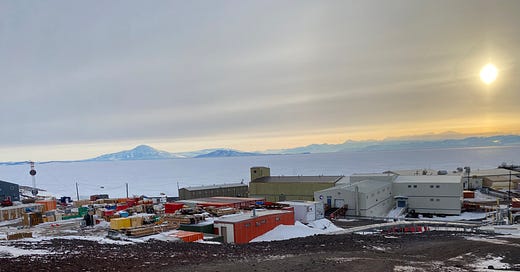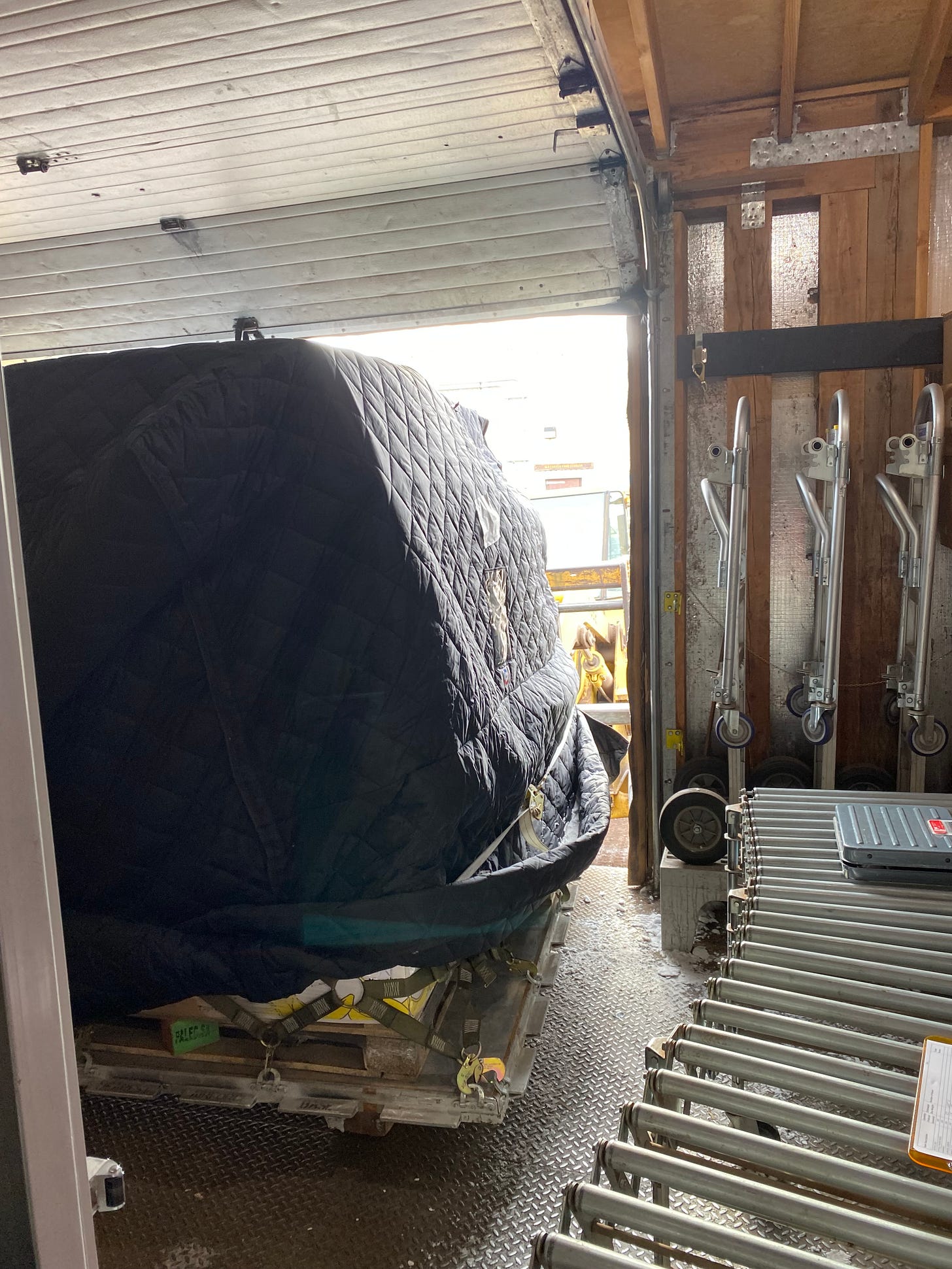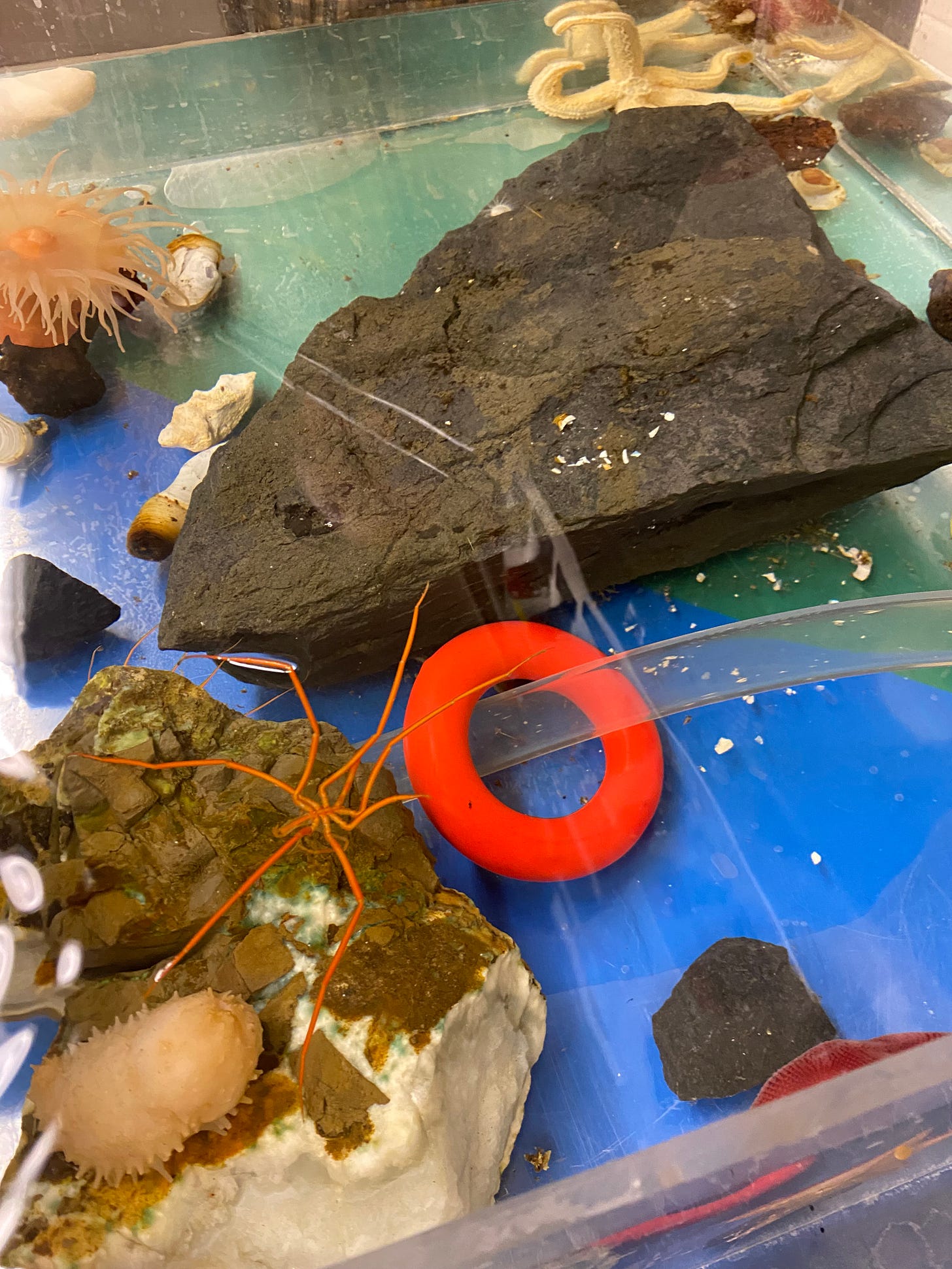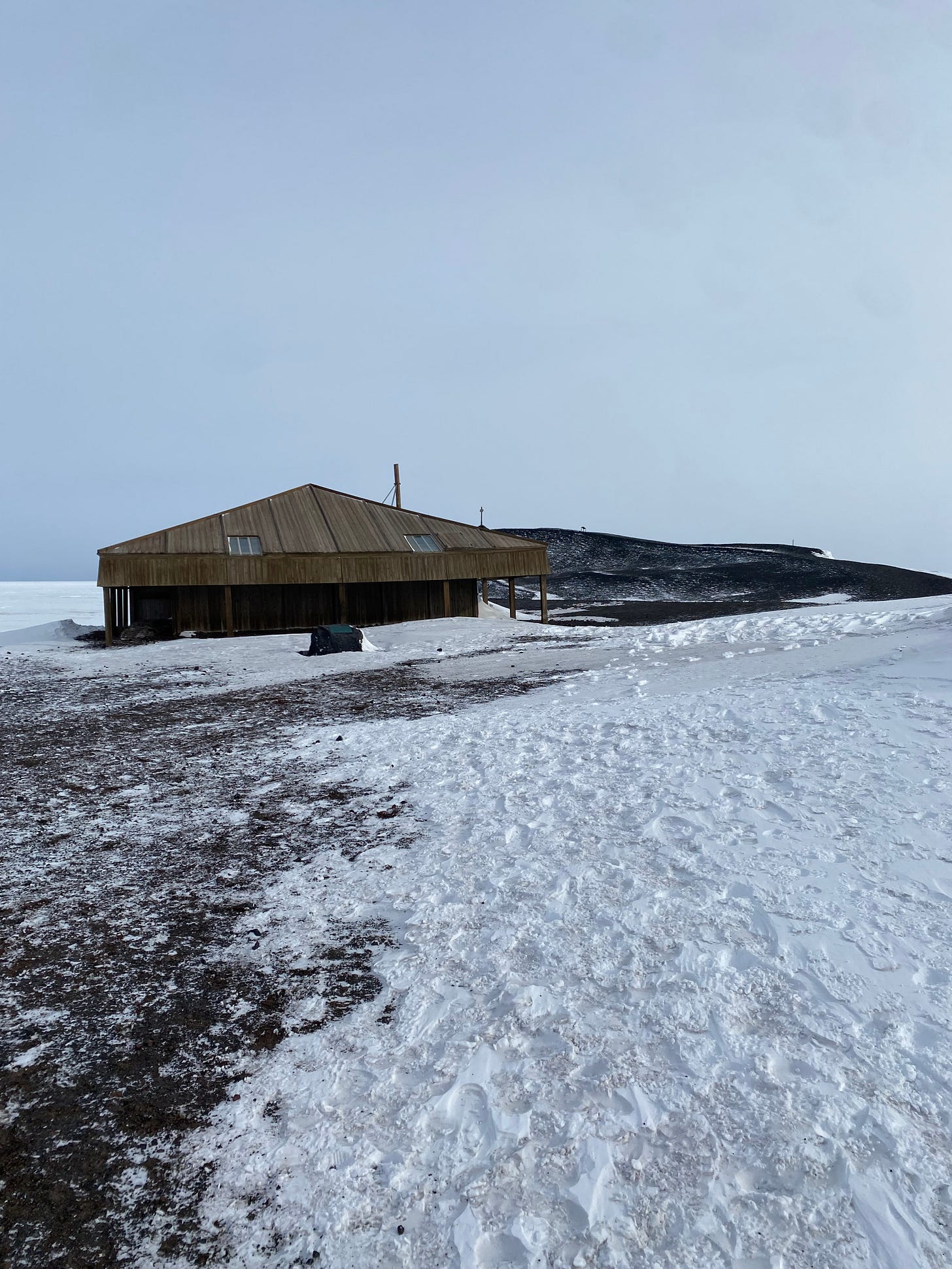My phone alarm sounds quietly next to my ear at 6 AM and I’m up and out of the room before 6:30, wearing my uniform and carrying my small red backpack containing Kindle, laptop and water bottle. My three roommates breathe quietly in the dark as I gingerly close the door, turning the handle so it doesn’t click, just as I did when I had sleeping children. Down one flight, I walk the line, blue plastic tray in hand, scanning for food. I come away with three tangerines and an English muffin with Skippy Super Crunchy and grape jelly.
The boisterous cafeteria buzzes around me as I sit solo reading Sara Wheeler’s biography of Cherry Garrard, appropriately titled Cherry. I sip the watery coffee lightened with powdered milk between bites of the muffin watching the clock for my shift time to close in. Fingers sticky, the jam marks the Kindle screen. Being out in the cold all day burns calories. Around me McMurdo’s workforce, most bundled up in snow pants or insulated bib overalls on the bottom and t-shirts on top, consume great piles of American breakfast food—untrustworthy looking scrambled eggs, bacon, make-your-own waffles, greasy potatoes, brimming bowls of breakfast cereal. For those with patience and time omelets and over-easy can be had from the “egg line” but it really is a line.
At 7:25 AM I scrape my peels into the food-contaminated waste bin, (varying grades of recycling are strictly practiced here) twist my long hair through the hole left by my cap’s clasp, pin it into a bun with a clip and go. I’m marked as galley crew in my uniform—coarse black pants and chef’s coat with a black cap that I’m fairly certain couldn’t be less flattering. (More chimney sweep than trucker.) My black non-slip Birkenstock clogs finish the look, such as it is. The supervising sous chefs wear red hats here; their bosses wear gray. Naturally, they’re called “red caps” but “gray hats.” With my black hat I’m at the bottom of the galley rung even if at pole (nobody says “the pole” around here much in the way nobody say “the Bywater” in New Orleans.) I’ll be a sous chef which would entitle me to red. Whatever. I don’t really care what color my hat is.
.
There’s nothing like a kitchen job to slam a girl into reality. Whether it’s Antarctica outside or not, a windowless commercial kitchen feeding 600+ bodies works the same way everywhere: it’s sweaty, loud and will give anyone uncertain of their place or method an ass-kicking. Add to that the personalities and quirks of those who choose to work in Antarctica and the challenges of the food supply and things get even more complicated than in a regular commercial kitchen.
Take the “Freshies” situation which, as I’ve explained previously, are what people down here call all fresh fruits and vegetables. As it turns out, Freshies are abundant in the early months of the summer season when the C-17s can still land on the Phoenix Airfield carrying 10,000 lb. pallets of lettuce, apples, tangerines, carrots, peppers, kiwis and even avocados. Getting them from New Zealand into the warmth of the walk-in the big blue dorm/cafeteria building known as 155 requires speed and finesse—and a blanket or two. If you’ve ever seen a frozen cucumber, tomato, or pepper you know cold destroys produce. Fifteen minutes in the C-17 cargo hold with the door open, ten out on the ice waiting for pick-up, or half an hour on the loading dock at station turns tender New Zealand fruits and vegetables to mush.
.
The challenges of feeding hundreds and hundreds of people don’t end there. Other than freshies, McMurdo’s kitchen supplies arrive once a year—yes, all at once. This canned, dried and frozen food arrives on a cargo ship (with an ice breaker to insure its safe passage in and out) during the warmest month in the Southern Ocean, January. Imagine trying to figure out every item you will need to feed yourself or your family more than year in advance; now imagine doing that for yourself and 900 other people who arrive to visit four or five months of the year.
For the four days at McMurdo I work in the bakery learning things like how to make sour cream from powder and bake cookies from “pucks” which are discs of frozen dough. On my first day I bake 2000 of these monsters—chocolate chip, sugar, white chocolate macadamia, chocolate-chocolate chip, oatmeal-cranberry. As you might imagine, as a baker I’ve never been a huge fan of pre-made cookies given the length of the ingredient list and the supermarket taste but after baking this many I have a fresh loathing for them. The hordes of hungry workers who eat them by the handful beg to differ.
When I’m on break or off-shift in the rowdy dining hall where crowds weave between the salad bar, the soft-serve machine (!), the deli area and the hot line, McMurdo reminds me of a college campus. The endless activities and clubs, the enthusiastic drinking culture, the cliques of young people sharing tables in the cafeteria three meals a day, the stinky, steamy shared bathrooms, the roommates and roommates’ alarms sounding each morning as snooze buttons sound again and again contributes to this impression. (Earth, Wind and Fire’s “September” will forever more trigger images of bunk-bed crossbeams and the sweet smell of the apples from Christchurch fermenting by my bed.)
But McMurdo Station isn’t a college by any stretch. The National Science Foundation (NSF) fiscal year 2023 budget for “U.S. Antarctic Support Logistical Support Activities” comes in at $94 million. McMurdo is run by and for science; without research scientists and the facilities to support their work, no country has any business being in Antarctica. I couldn’t agree more with this ideal as stated in the Antarctic Treaty but sometimes I wonder if we really need such a giant footprint here in McMurdo. (The 2015 Master Plan 2.0 is intended to organize a station built ad hoc since 1956-7.) That said, this hub supports all the science across the continent including at least a dozen field camps, the traverses (transports to remote outposts such as the South Pole and remote research stations) as well as the South Pole station. (Palmer, the northernmost station, relies on ocean resupply via Chile.)
I have talked to some impressive scientists during my brief time here—NASA researchers flying to the Antarctica’s “dry valleys” to compare the surfaces with Mars. That’s right, Mars. (The researchers will live in hard-sided tents furnished with supplies and propane stoves.) Then there’s the marine research. I was lucky enough to run into a generous scientist willing to show me the touch tank in off hours. I never knew marine creatures in Antarctica grow much larger than their warmer water relatives due, possibly, to the richness of sea life at such cold temperatures and hence their limited need to expend energy hunting.
I recognize that I don’t know or understand McMurdo but then, I’ve only been here for two weeks and much of that time I’ve been sleeping in my windowless dorm or working in the equally windowless kitchen performing essential but often repetitive tasks. Some days I might as well be working a nine-hour shift in a Des Moines nursing home until, that is, I open the back door to put the garbage out and the stunning white light hits me along with the shock of cold air. Each day, no matter how tired I am, I make myself walk out to Hut Point to admire the much-used hut and to check on the seals sleeping on the ice on the opposite side of the point.
It’s something of an overstatement to say that I came all this way to see Scott’s hut, known as the Discovery Hut, but referred to by Cherry and others simply as “Hut Point.” But not that much of an overstatement. The low-slung, flue-less hut, built and used by Scott during his 1901-1904 expedition, also provided much-needed shelter for Scott’s men at multiple occasions during the 1910-1912 expedition. Scott’s main base during this later expedition was the Terra Nova Hut, fifteen miles to the north at Cape Evans. The hut there, built of those pre-fab parts loaded in Lyttelton, produced a far larger, snugger lodging.
Cherry describes his first sighting of Hut Point just after arrival in 1911, when the barrier and the seals and beauty of the mountains were as fresh and marvelous to him as they are to me. “Rounding the promontory,” Cherry writes, “we saw the little jagged hut point and on it the cross placed there to Vince’s memory, all unchanged. There was the old Discovery hut and the bay in which the Discovery lay.” He also thrills to see Observation Hill where, two years later, he would help to erect the cross to Scott and his four men who died on their mission to reach the pole. It was Cherry who suggested a line from Tennyson’s “Ulysses” rather than a verse from the Bible: “To strive, to seek, to find and not to yield.”
Even if the hut never made comfortable living quarters for the men who used it, when shelter was needed it was far better than being out in the open, at the mercy of the famously fickle and furious Hut Point winds. I’ve often relived Cherry, E.A. Wilson and Birdie Bowers arrival at the drafty, icy hut after their unspeakably difficult winter journey to Cape Crozier where Wilson desperately wanted to collect eggs to “work out the embryology of the Emperor penguins.” The eggs had eluded him for many years.
Vividly as Cherry describes the suffering of frostbitten hands blistering, -70 F. temperatures, hurricane force winds and sleeping bags and clothing frozen hard into the shape of the body I’m not sure any reader can grasp the suffering of the men on this ill-advised journey. It was a near-death experience; at many points Cherry confesses he wished himself in the comfort of a crevasse and the fast, painless death it would bring. After reaching Cape Crozier, the freezing, exhausted, hungry men gathered several Emperor penguin eggs, killed a few penguins for blubber to heat their shelter and, after several near-death misses, rushed homeward. They were running perilously low on fuel oil; without it they would die of cold. As the men slogged the seventy miles toward Hut Point, the fantasy of impossible pleasures sustained them. Cherry confesses: “I wanted peaches and syrup—badly. We had them at the hut, sweeter and more luscious than you imagine.”
Although Cherry would have to wait for his peaches, at Hut Point he and the men hoped to find the other men had delivered “some dry sleeping bags from Cape Evans to greet us there.” I feel their disappointment when they arrive at last, half-dead, to find nothing had been sent down, “no sleeping bags, no sugar, but [there was] plenty of oil. Inside the hut we pitched a dry tent left there since Depot Journey days; set two primuses going in it; sat dozing in our bags; and drank cocoa without sugar so thick that next morning we were gorged with it. We were very happy,” Cherry writes, “falling asleep between each mouthful.”
This is why each day after being on my feet for nine hours, I climb the stairs to my dorm, shower and then bundle up in my quilted silver pants, cashmere beanie and Big Red to head out along the well-travelled road to Hut Point. Below, on the sea ice to the left, an ice dock under construction to accommodate the cargo ship arriving in January looks like a decent skating rink.
I’m soon before the hut itself. Outside, under the eaves, I stare at the nearly petrified seal that evidently crawled there some years ago to die. The hut itself is a simple square weathered wooden structure, with a deep overhang all around. I yearns to see the inside but it’s too early in the season for tours. On my return in February I hope to see both the interior of this hut and Scott’s even more extensive lodging at Cape Evans, both preserved and protected by the Antarctic Heritage Trust.
Late in my second week a pup appears amongst the sluggish black Weddell seals sleeping on the ice just over the point. The baby appears slippery as a little fish and too fragile to survive in the bitter cold. I am grateful for Big Red as I stand there, trying and failing to get a decent picture with my outdated iPhone as the newborn attempts to find a teat by flopping its way around the circumfluence of its mother. She never moves. How I love standing there, the ugly if loveable buildings of McMurdo out of sight; all that I can see are the mountains across the Ross Sea, floating white in the distance, smooth and still until the sun’s rays hit the icy flow of the glaciers between the peaks. The snow sparkles, lighting up the angles, bringing some unholy beauty to the whole scene so different than the jagged black hillside at my back, crisscrossed with roads. It’s as if McMurdo were built for maximum contrast with the environment. If so, it has succeeded
I’ll be sorry to leave this crazy town but after two weeks of chaos, I’m ready for the quiet of the South Pole. There are four flights carrying summer staff to the pole this coming week. I was on the fourth, emailed the head of South Pole Station to politely say I could be packed in a flash; got moved up to the third flight and then, surprise, moved again to the second flight. Yay! The flight was supposed to leave at 8:15 AM on the 30th,. Weather killed all flights that day. On the 31st an Italian contingent in need of a lift to their station preceded the Pole trip so that was that. I’m hoping tomorrow, November 1, will be the magic day since I’ve been in the kitchen, working, every day I don’t go. It’s not so bad but still, I’m ready. Besides, I’ve been living out of a carry-on bag for the past two nights because “bag drag” happened on Sunday. That’s when passengers bring every single item they possess to baggage services with Extreme Cold Weather (ECW) gear in one bag, top priority items in a bag marked #1, and stuff that can wait a few weeks in bag #2. It’s the whole weigh-in thing all over again, with carry-on, ECW and bodyweight calculated along with the weight of bag #1.
Tonight, I’ll take one last walk to Hut Point to admire the historic building and the seals. (It’s light all night, of course, I can go whenever I want to.) After that, it’s to bed early, as always. Tomorrow morning I’ll be watching the board at 7 AM because that’s the time the pilots have committed to making the call as to whether it’s safe to fly given winds, storms and temperatures. If I go, I’ll be flying at low altitude up the spine of the Transantarctic Range. Maybe tomorrow night I’ll be eating sitting down to my first meal at the bottom of the world
.











Hi Cree. Please keep up the posts. What an amazing adventure.
I just watched the movie Whiteout, a murder mystery that takes place in Antarctica. Not a bad flick. While watching it, several questions popped into my head.
--What is the law enforcement presence there? In the movie, there’s a US Marshal, and UN Investigator stationed there.
--What about military presence?
--Are there any “lifers” you’ve encountered, or “South Pole recidivists”?
--When is the first full sunset? Do you expect to see the Southern Lights (or the Southern Cross) at some point?
--What initiation rituals will you be/have you been subjected to?
--What is the thermostat set at in your living spaces?